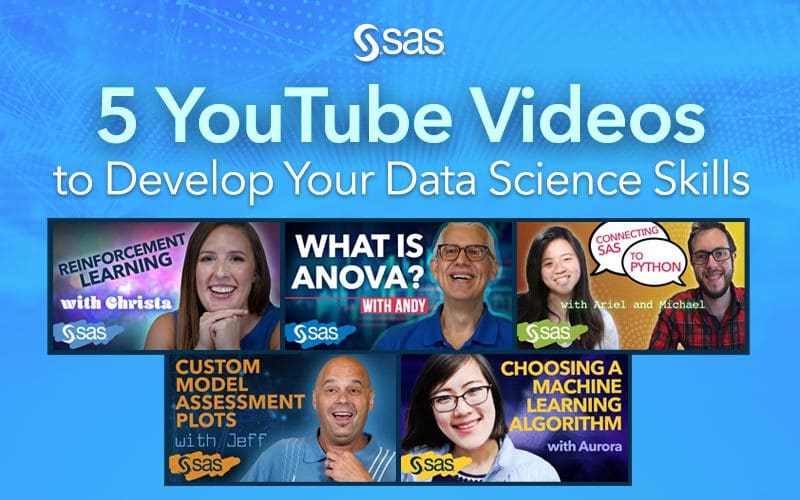Quick Data Science Tips and Tricks to Learn SAS
How To Tutorials with SAS data scientists and analytics instructors.
We all know there’s the demand for data science skills continues to grow at exponential rates. And seemingly our available time to learn seems to decrease. But sometimes all you need is to learn a quick tip or trick to solve the task at hand, or only have time to dedicate short increments of time to learn a new skill. Regardless of the scenario, you can tune in to the SAS Users YouTube channel where several SAS Tutorials are posted each month. You’ll hear from a variety of experts on different topics for various skill levels. So, whether you’re just starting out or are far more advanced, subscribe to the channel to continue to learn data science skills – even with the limited time you have available.
Below you’ll find some of our most popular and recent videos to check out. And if you want to get notified about any new SAS How To Tutorial releases, make sure you subscribe.
SAS Tutorial | How to Choose a Machine Learning Algorithm
With so many machine learning algorithms to choose from, it’s hard to know which one is best for your specific scenario. In this SAS How To Tutorial, SAS data scientist and technical instructor, Aurora Peddycord-Liu provides the pros and cons of some commonly used machine learning models like decision trees and neural networks. Get a better understanding of what deep learning is (and isn’t) and then watch as Peddycord-Liu shows how to assess and compare models in SAS Model Studio. Plus, you’ll be able to access the data she uses on GitHub so you can follow along, then continue your learning with additional resources.
SAS Tutorial | How to Connect SAS and Python Using Jupyter Notebooks
Is Python your current code of choice? In this How To Tutorial, learn how to connect SAS and Python in a few lines of code during this demo shown in Jupyter Notebooks. Data Science Interns Ariel Chien and Michael Senter tell you why you may want to combine SAS and Python and show you how to build a map of the U.S. spread of COVID-19 with both languages. They use SAS OnDemand for Academics – free SAS software in the cloud – for the demo, which you can also get access to in order to follow along in what they’re demonstrating.
SAS Tutorial | Learn SAS with Jeff Thompson
From Receiver Operating Characteristics (ROC) Charts and how to compare models to building custom model assessment plots, this SAS Users YouTube playlist from analytics expert Jeff Thompson has six videos that cover a wide variety of skills to learn.
ANOVA stands for Analysis Of Variance, which is used to compare the averages or means of two or more populations to better understand how they differ. In this SAS How To Tutorial, SAS’ technical training consultant Andy Ravenna gives an introduction and definition of ANOVA, walks through the steps to calculate values of an ANOVA table, and then shows you how to apply it in SAS. You’ll be able to access the code and find the data used in the video if you want to do this side-by-side with Ravenna.
SAS Tutorial | Reinforcement Learning in SAS
Learn how to build a custom environment for reinforcement learning in SAS with SAS Trainer Christa Cody. In this SAS How To Tutorial, she shows you how to build a custom environment in Python, based on an OpenAI gym standards and uses a Jupyter notebook to run the environment with reinforcement learning in SAS.
Christa uses a simplistic GridWorld-based example where a reinforcement agent is moving through a path of states to reach the goal. She takes you through the values and reward progression of the agent’s path. The scenario is easy to follow: a farmer is trying to reach berries (the goal) as quickly as possible while avoiding snakes (snakes and steps result in negative rewards). You’ll see how to apply reinforcement learning to come up with the most efficient, optimal path to the berries – and even access the notebook and custom environment from GitHub.
Even if the above How To Tutorials aren’t exactly what you’re looking for, be sure to check out the other video content available on the SAS Users YouTube channel. You’ll find everything from three-minute quick hits to 30-minute + sessions on a variety of topics and skill levels with additional resources and access to data to ensure you have what you need to continue learning.

